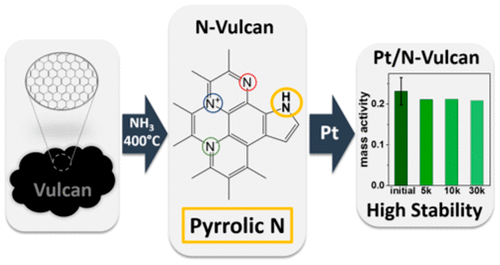当前位置:
X-MOL 学术
›
Chem. Mater.
›
论文详情
Our official English website, www.x-mol.net, welcomes your
feedback! (Note: you will need to create a separate account there.)
Impact of Carbon Support Functionalization on the Electrochemical Stability of Pt Fuel Cell Catalysts
Chemistry of Materials ( IF 7.2 ) Pub Date : 2018-09-24 00:00:00 , DOI: 10.1021/acs.chemmater.8b03612 Henrike Schmies , Elisabeth Hornberger , Björn Anke , Tilman Jurzinsky 1 , Hong Nhan Nong 2 , Fabio Dionigi , Stefanie Kühl , Jakub Drnec 3 , Martin Lerch , Carsten Cremers 1 , Peter Strasser
Chemistry of Materials ( IF 7.2 ) Pub Date : 2018-09-24 00:00:00 , DOI: 10.1021/acs.chemmater.8b03612 Henrike Schmies , Elisabeth Hornberger , Björn Anke , Tilman Jurzinsky 1 , Hong Nhan Nong 2 , Fabio Dionigi , Stefanie Kühl , Jakub Drnec 3 , Martin Lerch , Carsten Cremers 1 , Peter Strasser
Affiliation

|
Nitrogen-enriched porous carbons have been discussed as supports for Pt nanoparticle catalysts deployed at cathode layers of polymer electrolyte membrane fuel cells (PEMFC). Here, we present an analysis of the chemical process of carbon surface modification using ammonolysis of preoxidized carbon blacks, and correlate their chemical structure with their catalytic activity and stability using in situ analytical techniques. Upon ammonolysis, the support materials were characterized with respect to their elemental composition, the physical surface area, and the surface zeta potential. The nature of the introduced N-functionalities was assessed by X-ray photoelectron spectroscopy. At lower ammonolysis temperatures, pyrrolic-N were invariably the most abundant surface species while at elevated treatment temperatures pyridinic-N prevailed. The corrosion stability under electrochemical conditions was assessed by in situ high-temperature differential electrochemical mass spectroscopy in a single gas diffusion layer electrode; this test revealed exceptional improvements in corrosion resistance for a specific type of nitrogen modification. Finally, Pt nanoparticles were deposited on the modified supports. In situ X-ray scattering techniques (X-ray diffraction and small-angle X-ray scattering) revealed the time evolution of the active Pt phase during accelerated electrochemical stress tests in electrode potential ranges where the catalytic oxygen reduction reaction proceeds. Data suggest that abundance of pyrrolic nitrogen moieties lower carbon corrosion and lead to superior catalyst stability compared to state-of-the-art Pt catalysts. Our study suggests with specific materials science strategies how chemically tailored carbon supports improve the performance of electrode layers in PEMFC devices.
中文翻译:

碳载体功能化对Pt燃料电池催化剂电化学稳定性的影响
已经讨论了富氮多孔碳作为部署在聚合物电解质膜燃料电池(PEMFC)阴极层上的Pt纳米颗粒催化剂的载体。在这里,我们对使用预氧化炭黑进行氨解的碳表面改性的化学过程进行了分析,并使用原位分析技术将其化学结构与其催化活性和稳定性相关联。进行氨解后,就载体材料的元素组成,物理表面积和表面ζ电位进行了表征。通过X射线光电子能谱评估了引入的N-官能团的性质。在较低的氨解温度下,吡咯-N始终是最丰富的表面物质,而在升高的处理温度下,吡啶-N占优势。通过原位高温差示电化学质谱法在单个气体扩散层电极中评估电化学条件下的腐蚀稳定性。该测试表明,对于特定类型的氮改性,耐腐蚀性得到了显着提高。最后,将Pt纳米颗粒沉积在改性载体上。原位X射线散射技术(X射线衍射和小角度X射线散射)显示了在催化氧还原反应进行的电极电位范围内,加速电化学应力测试期间活性Pt相的时间演变。数据表明,与最新的Pt催化剂相比,丰富的吡咯氮部分降低了碳腐蚀,并导致了优异的催化剂稳定性。
更新日期:2018-09-24
中文翻译:

碳载体功能化对Pt燃料电池催化剂电化学稳定性的影响
已经讨论了富氮多孔碳作为部署在聚合物电解质膜燃料电池(PEMFC)阴极层上的Pt纳米颗粒催化剂的载体。在这里,我们对使用预氧化炭黑进行氨解的碳表面改性的化学过程进行了分析,并使用原位分析技术将其化学结构与其催化活性和稳定性相关联。进行氨解后,就载体材料的元素组成,物理表面积和表面ζ电位进行了表征。通过X射线光电子能谱评估了引入的N-官能团的性质。在较低的氨解温度下,吡咯-N始终是最丰富的表面物质,而在升高的处理温度下,吡啶-N占优势。通过原位高温差示电化学质谱法在单个气体扩散层电极中评估电化学条件下的腐蚀稳定性。该测试表明,对于特定类型的氮改性,耐腐蚀性得到了显着提高。最后,将Pt纳米颗粒沉积在改性载体上。原位X射线散射技术(X射线衍射和小角度X射线散射)显示了在催化氧还原反应进行的电极电位范围内,加速电化学应力测试期间活性Pt相的时间演变。数据表明,与最新的Pt催化剂相比,丰富的吡咯氮部分降低了碳腐蚀,并导致了优异的催化剂稳定性。











































 京公网安备 11010802027423号
京公网安备 11010802027423号